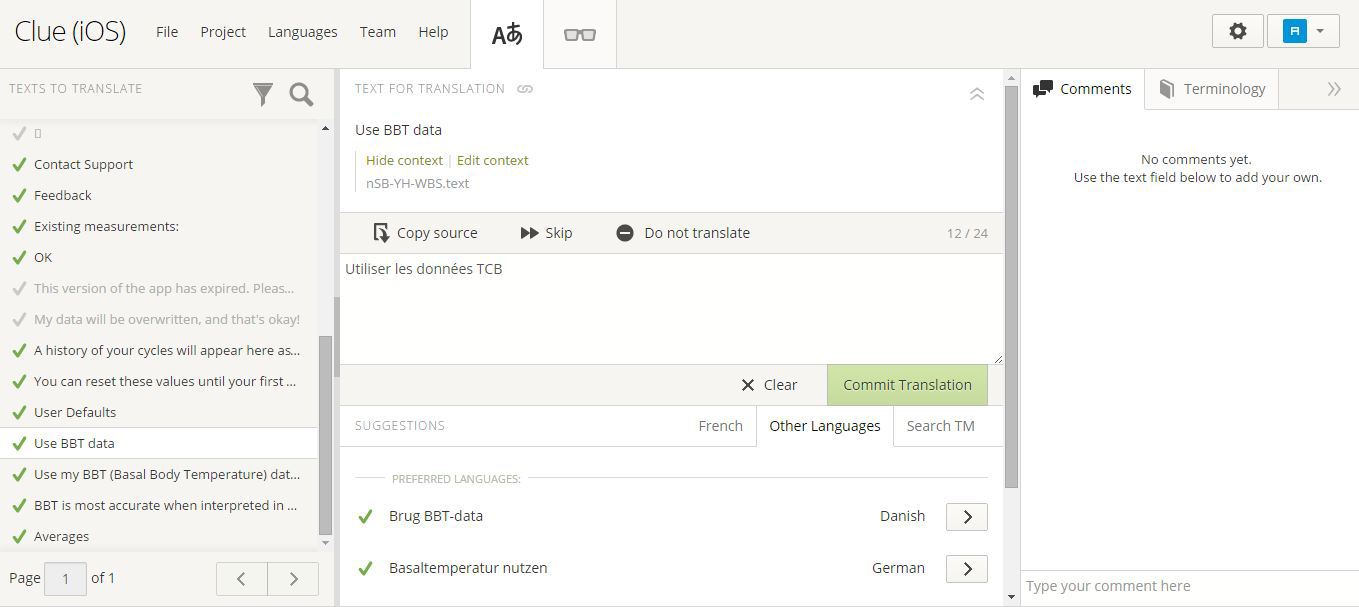 These are just a few of the challenges that we at Alconost conquer every day thanks to a tool that makes the localization process almost magic. In medicine, they would call it a panacea. As localizers though, we know it by the name of Crowdin. The Crowdin crowd platform has enabled us to localize apps, sites, and games into 40+ languages for dozens of clients - all at the same time. Here are the six biggest localization difficulties that Crowdin solves: 1. So. Many. Formats. The variety of file formats to localize is simply astounding: .xml, .strings, .resx, .properties, .po, .yml, .json, .ini, .xliff, .csv, .xlsx and many, many more. As soon as you load a file into Crowdin, it is converted and shown to translators with text only - no code or technical information. This is a big deal, since translators can otherwise get confused or accidentally introduce errors into the functional aspects of your software (imagine the damage that can be caused by a simple encoding error or extra ">").
These are just a few of the challenges that we at Alconost conquer every day thanks to a tool that makes the localization process almost magic. In medicine, they would call it a panacea. As localizers though, we know it by the name of Crowdin. The Crowdin crowd platform has enabled us to localize apps, sites, and games into 40+ languages for dozens of clients - all at the same time. Here are the six biggest localization difficulties that Crowdin solves: 1. So. Many. Formats. The variety of file formats to localize is simply astounding: .xml, .strings, .resx, .properties, .po, .yml, .json, .ini, .xliff, .csv, .xlsx and many, many more. As soon as you load a file into Crowdin, it is converted and shown to translators with text only - no code or technical information. This is a big deal, since translators can otherwise get confused or accidentally introduce errors into the functional aspects of your software (imagine the damage that can be caused by a simple encoding error or extra ">").
Pain-free localization is the dream of everyone who develops software for foreign markets. Interfaces with dense thickets of terms, rendered in many languages, make this dream even stronger. Perhaps it is strongest of all among developers, agile or otherwise, who constantly release updates and with the same regularity must translate... translate... and translate an unending stream of strings.  These are just a few of the challenges that we at Alconost conquer every day thanks to a tool that makes the localization process almost magic. In medicine, they would call it a panacea. As localizers though, we know it by the name of Crowdin. The Crowdin crowd platform has enabled us to localize apps, sites, and games into 40+ languages for dozens of clients - all at the same time. Here are the six biggest localization difficulties that Crowdin solves: 1. So. Many. Formats. The variety of file formats to localize is simply astounding: .xml, .strings, .resx, .properties, .po, .yml, .json, .ini, .xliff, .csv, .xlsx and many, many more. As soon as you load a file into Crowdin, it is converted and shown to translators with text only - no code or technical information. This is a big deal, since translators can otherwise get confused or accidentally introduce errors into the functional aspects of your software (imagine the damage that can be caused by a simple encoding error or extra ">").
These are just a few of the challenges that we at Alconost conquer every day thanks to a tool that makes the localization process almost magic. In medicine, they would call it a panacea. As localizers though, we know it by the name of Crowdin. The Crowdin crowd platform has enabled us to localize apps, sites, and games into 40+ languages for dozens of clients - all at the same time. Here are the six biggest localization difficulties that Crowdin solves: 1. So. Many. Formats. The variety of file formats to localize is simply astounding: .xml, .strings, .resx, .properties, .po, .yml, .json, .ini, .xliff, .csv, .xlsx and many, many more. As soon as you load a file into Crowdin, it is converted and shown to translators with text only - no code or technical information. This is a big deal, since translators can otherwise get confused or accidentally introduce errors into the functional aspects of your software (imagine the damage that can be caused by a simple encoding error or extra ">").  The variety of file formats in one project
The variety of file formats in one project
 Glossary
Glossary .xml file in Crowdin
.xml file in Crowdin
 These are just a few of the challenges that we at Alconost conquer every day thanks to a tool that makes the localization process almost magic. In medicine, they would call it a panacea. As localizers though, we know it by the name of Crowdin. The Crowdin crowd platform has enabled us to localize apps, sites, and games into 40+ languages for dozens of clients - all at the same time. Here are the six biggest localization difficulties that Crowdin solves: 1. So. Many. Formats. The variety of file formats to localize is simply astounding: .xml, .strings, .resx, .properties, .po, .yml, .json, .ini, .xliff, .csv, .xlsx and many, many more. As soon as you load a file into Crowdin, it is converted and shown to translators with text only - no code or technical information. This is a big deal, since translators can otherwise get confused or accidentally introduce errors into the functional aspects of your software (imagine the damage that can be caused by a simple encoding error or extra ">").
These are just a few of the challenges that we at Alconost conquer every day thanks to a tool that makes the localization process almost magic. In medicine, they would call it a panacea. As localizers though, we know it by the name of Crowdin. The Crowdin crowd platform has enabled us to localize apps, sites, and games into 40+ languages for dozens of clients - all at the same time. Here are the six biggest localization difficulties that Crowdin solves: 1. So. Many. Formats. The variety of file formats to localize is simply astounding: .xml, .strings, .resx, .properties, .po, .yml, .json, .ini, .xliff, .csv, .xlsx and many, many more. As soon as you load a file into Crowdin, it is converted and shown to translators with text only - no code or technical information. This is a big deal, since translators can otherwise get confused or accidentally introduce errors into the functional aspects of your software (imagine the damage that can be caused by a simple encoding error or extra ">"). Comments

April 18, 2015 10:00 AM

This is an ad. Adverticle, advertorial, whatever, same thing. If you're paying to support the site, fine, say so. Otherwise... ban hammer!
June 10, 2015 03:24 PM

I consider the online platform POEditor to be a better software localization solution, I mean the translation interface is clearly easier to understand. If I'm not mistaking, it's even cheaper. The pricing scheme is not the same, though, so it could depend on the product you want to localize.
August 06, 2015 09:05 AM
Pain-free localization is the dream of everyone who develops software for foreign markets. It's a true story about a tool that makes the localization process almost magic!
Advertisement
Recommended Tutorials
Advertisement
Other Tutorials by Alconost
11828 views
Advertisement



The only reason I came here is due to that picture of the cat.